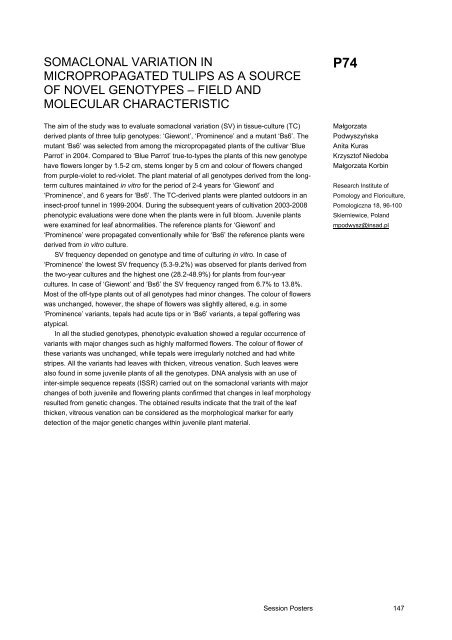XXIIIrd International Eucarpia symposium, Section Ornamentals ...
XXIIIrd International Eucarpia symposium, Section Ornamentals ...
XXIIIrd International Eucarpia symposium, Section Ornamentals ...
You also want an ePaper? Increase the reach of your titles
YUMPU automatically turns print PDFs into web optimized ePapers that Google loves.
SOMACLONAL VARIATION IN<br />
MICROPROPAGATED TULIPS AS A SOURCE<br />
OF NOVEL GENOTYPES – FIELD AND<br />
MOLECULAR CHARACTERISTIC<br />
The aim of the study was to evaluate somaclonal variation (SV) in tissue-culture (TC)<br />
derived plants of three tulip genotypes: ‘Giewont’, ‘Prominence’ and a mutant ‘Bs6’. The<br />
mutant ‘Bs6’ was selected from among the micropropagated plants of the cultivar ‘Blue<br />
Parrot’ in 2004. Compared to ‘Blue Parrot’ true-to-types the plants of this new genotype<br />
have flowers longer by 1.5-2 cm, stems longer by 5 cm and colour of flowers changed<br />
from purple-violet to red-violet. The plant material of all genotypes derived from the longterm<br />
cultures maintained in vitro for the period of 2-4 years for ‘Giewont’ and<br />
‘Prominence’, and 6 years for ‘Bs6’. The TC-derived plants were planted outdoors in an<br />
insect-proof tunnel in 1999-2004. During the subsequent years of cultivation 2003-2008<br />
phenotypic evaluations were done when the plants were in full bloom. Juvenile plants<br />
were examined for leaf abnormalities. The reference plants for ‘Giewont’ and<br />
‘Prominence’ were propagated conventionally while for ‘Bs6’ the reference plants were<br />
derived from in vitro culture.<br />
SV frequency depended on genotype and time of culturing in vitro. In case of<br />
‘Prominence’ the lowest SV frequency (5.3-9.2%) was observed for plants derived from<br />
the two-year cultures and the highest one (28.2-48.9%) for plants from four-year<br />
cultures. In case of ‘Giewont’ and ‘Bs6’ the SV frequency ranged from 6.7% to 13.8%.<br />
Most of the off-type plants out of all genotypes had minor changes. The colour of flowers<br />
was unchanged, however, the shape of flowers was slightly altered, e.g. in some<br />
‘Prominence’ variants, tepals had acute tips or in ‘Bs6’ variants, a tepal goffering was<br />
atypical.<br />
In all the studied genotypes, phenotypic evaluation showed a regular occurrence of<br />
variants with major changes such as highly malformed flowers. The colour of flower of<br />
these variants was unchanged, while tepals were irregularly notched and had white<br />
stripes. All the variants had leaves with thicken, vitreous venation. Such leaves were<br />
also found in some juvenile plants of all the genotypes. DNA analysis with an use of<br />
inter-simple sequence repeats (ISSR) carried out on the somaclonal variants with major<br />
changes of both juvenile and flowering plants confirmed that changes in leaf morphology<br />
resulted from genetic changes. The obtained results indicate that the trait of the leaf<br />
thicken, vitreous venation can be considered as the morphological marker for early<br />
detection of the major genetic changes within juvenile plant material.<br />
P74<br />
Małgorzata<br />
Podwyszyńska<br />
Anita Kuras<br />
Krzysztof Niedoba<br />
Małgorzata Korbin<br />
Research Institute of<br />
Pomology and Floriculture,<br />
Pomologiczna 18, 96-100<br />
Skierniewice, Poland<br />
mpodwysz@insad.pl<br />
Session Posters 147














